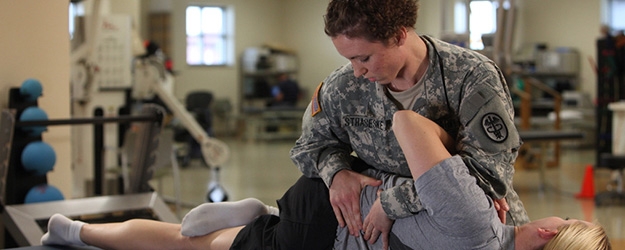
Those who serve in the U.S. military are heroes, dedicating their lives to ensure the safety of our country. Military life requires many physical challenges, and for the troops to be in optimal shape they must undergo rigorous training. Common tasks include carrying heavy loads, running with body armor, jumping out of planes and much more. These types of activities can have a long-term impact on a person’s body, so it shouldn’t come as a surprise that many of our military suffer from chronic pain.
For many active duty military, chiropractic care is not easily accessible while they are serving. It could be difficult to see a doctor of chiropractic, leading many active duty members to simply deal with the pain. Unfortunately, too few military bases have a doctor of chiropractic (DC) onsite. According to a 2005 Government Accountability Office report, while there is a DC at 60 military bases around the country, only 54 percent of servicemen and women eligible for chiropractic care can reasonably access the benefit. Could better access to chiropractic care be the answer to getting military personnel on the road to living a pain-free life?
Care for Back and Neck Pain
Back pain can make life miserable and it’s common in the military. According to the 2016 National Health Interview Survey, more that 43% of veterans deal with joint pain. Over 30% deal with back pain and another 16% with neck pain. Randomized trials have found that spinal manipulation can be effective for lower back pain. One 2013 studyspecifically evaluated chiropractic care with general medical care in military personnel, 18-35 years old. The results suggest reduced pain and improved physical well-being and function under chiropractic care, as compared to patients who received only standard medical care.
These studies confirm the well-established fact that most individuals with back pain find relief with chiropractic care. The U.S. is not the only country utilizing chiropractic care for military back pain either. The Canadian Armed Forces also offer chiropractic services, and a survey among their military personnel found that more than 90 percent were satisfied with their own chiropractic services.
The Need for Safer Pain Management Approaches
The words “chronic pain” can be tough to come to terms with – after all, no one wants to live their life unable to do tasks they once enjoyed. Chiropractic care opens a new world for military personnel to live better, take back their quality of life and enhance their readiness for service.
Active-duty military personnel embrace chiropractic care and report that it enhances health and well-being while reducing stress. Surveys indicate military personnel take advantage of chiropractic services up to 7 times more often than civilians.
Now that care is accessible to active duty personnel through Tricare, we need to promote awareness and use among active duty members. And as people become more aware of the benefits of chiropractic care, it is our hope that those who have given so much to our country have easier access to chiropractic services.








































